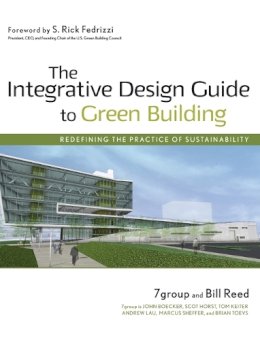
Stock image for illustration purposes only - book cover, edition or condition may vary.
The Integrative Design Guide to Green Building
7Group
FREE Delivery in Ireland
Description for The Integrative Design Guide to Green Building
Hardcover. Written for architects and the design and construction team, this is a comprehensive guide to an integrated design process to create more sustainable buildings. The book is organized in a sequence similar to that employed by conventional design, so that it can be utilized as a real-world guide. Series: Wiley Series in Sustainable Design. Num Pages: 416 pages, Illustrations. BIC Classification: AMC. Category: (P) Professional & Vocational. Dimension: 236 x 208 x 31. Weight in Grams: 968.
"The members of 7group and Bill Reed are examples writ large of the kind of leadership that is taking this idea of green building and forming it into reality, by helping change minds, building practice, and design process."
—from the Foreword by S. Rick Fedrizzi President, CEO, and Founding Chair, U.S. Green Building Council
A whole-building approach to sustainability
The integrative design process offers a new path to making better green building decisions and addressing complex issues that threaten living systems. In The Integrative Design Guide to Green Building: Redefining the Practice of Sustainability, 7group's principals and integrative design pioneer ... Read moreBill Reed introduce design and construction professionals to the concepts of whole building design and whole systems. With integrative thinking that reframes what sustainability means, they provide a how-to guide for architects, designers, engineers, developers, builders, and other professionals on incorporating integrative design into every phase of a project.
This practical manual:
- Explains the philosophy and underpinnings of effective integrative design, addressing systems thinking and building and community design from a whole-living system perspective
- Details how to implement integrative design from the discovery phase to occupancy, supported by process outlines, itemized tasks, practice examples, case studies, and real-world stories illustrating the nature of this work
- Explores the deeper understanding of integration that is required to transform architectural practice and our role on the planet
This book, both practical and thoughtful, will help you deliver your vision of a sustainable environment.
Show Less
Product Details
Publisher
John Wiley and Sons Ltd United Kingdom
Series
Wiley Series in Sustainable Design
Place of Publication
New York, United States
Shipping Time
Usually ships in 7 to 11 working days
About 7Group
7group, based in Kutztown, Pennsylvania, includes principals John Boecker, Scot Horst, Tom Keiter, Andrew Lau, Marcus Sheffer, and Brian Toevs, who bring a unique integration of expertise in design, engineering, energy and daylight modeling, materials assessments, commissioning, education, and communications to their work. Internationally recognized thought leaders in the green building movement, they have led countless teams through the practical ... Read moreimplementation of integrative design on building projects of all types around the world. 7group also has been directly and deeply involved with the development of the LEED Green Building Rating System, including experience on more than 100 LEED projects. Scot Horst currently serves as chair of the U.S. Green Building Council’s LEED Steering Committee. Bill Reed is an architect and internationally recognized proponent and practitioner of integrative design. He is a principal in three firms: the Integrative Design Collaborative, Regenesis, Inc., and Delving Deeper—organizations working to lift development into full integration with living systems. He served as co-chair of the LEED Technical Committee from its inception in 1994 through 2003, is a member of the LEED Advanced faculty, and one of the first of twelve USGBC trainers of the LEED Rating System. Show Less
Reviews for The Integrative Design Guide to Green Building
"The book is an in-depth study of sustainable design practices, but particularly as it relates to new building construction. The book's primary audience is commercial construction consultants. However, their concepts apply to residential design, too." (The Designer, Winter 2009/2010)

.png)